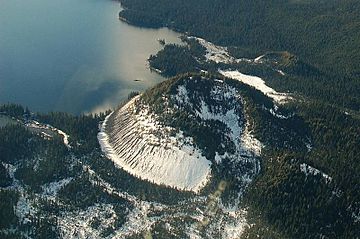Kostal Cone facts for kids
Quick facts for kids Kostal Cone |
|
|---|---|

Kostal Cone
|
|
| Highest point | |
| Elevation | 1,440 m (4,720 ft) |
| Prominence | 190 m (620 ft) |
| Geography | |
| Parent range | Cariboo Mountains |
| Geology | |
| Age of rock | Holocene |
| Mountain type | Cinder cone |
| Last eruption | 1550 (?) |
Kostal Cone, also called Kostal Volcano and Fire Mountain, is a young cinder cone in Wells Gray Provincial Park in east-central British Columbia, Canada. It rises from the northeast shore of Kostal Lake in the Cariboo Mountains. Standing at 1,440 m (4,724 ft) tall, Kostal Cone is one of the smaller volcanoes in the Wells Gray-Clearwater volcanic field.
How Old Is Kostal Cone?
Scientists believe Kostal Cone has been active as recently as 7,600 years ago. However, it's more likely that its last eruption happened less than 1,000 years ago.
To figure out a volcano's age, scientists often use special dating methods:
- Potassium-argon dating is a method used for very old rocks, usually over 100,000 years old. Kostal Cone is too young for this method.
- Radiocarbon dating is used for organic materials like wood or plants. Scientists look for charred (burned) plant material from eruptions. So far, none has been found at Kostal Cone.
Instead, scientists used a method called dendrochronology. This involves studying the growth rings of trees. Just like the rings in a tree trunk tell you how old the tree is, they can also show when volcanic activity happened. By studying trees growing on Kostal Cone, scientists found that the volcano is about 400 years old. This makes Kostal Cone the youngest volcano in the Wells Gray-Clearwater volcanic field and one of the newest volcanoes in all of Canada!
What Is Kostal Cone Made Of?
Kostal Cone is a cinder cone, which means it's built from small pieces of hardened lava called cinder. When the volcano erupted, hot lava shot into the air like a giant fountain. As these lava pieces cooled and fell back down, they piled up around the volcano's opening, forming its cone shape.
At the very top of Kostal Cone, you can see a bowl-shaped crater. The lava flows from Kostal's eruption 400 years ago are made of a type of rock called basalt. This basalt lava spread out to form a wide, flat area known as a lava bed.
Kostal Cone is a great example of how volcanoes have been active in the Wells Gray-Clearwater volcanic field since the last ice age. Other cool volcanic features nearby include the Dragon's Tongue lava flow from Dragon Cone and the Flourmill Volcanoes north of Mahood Lake.


